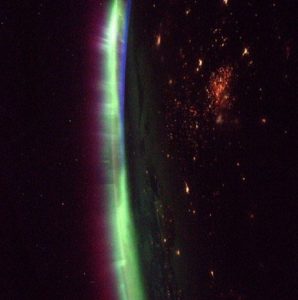
Scientists from York University in Canada have solved the millennium-old mystery of ‘bright nights’ or ‘nocturnal sun’. The phenomenon of ‘bright nights’ refers to occasional occurrence of an unexplained glow in the night skies which allowed people to see far-away objects like mountains, make out pebbles on the ground, and even read newspapers.
Professor Gordon Shepherd of York University and his colleague, Youngmin Cho, explain that waves in the upper atmosphere sometimes converge over particular regions on Earth, which amplifies naturally occurring airglow (occurring about 60 miles above Earth’s surface). The airglow is a faint light (generally green) in the night sky that is usually not noticed, but on bright nights, it becomes visible to naked eyes. Chemical reactions in the upper reaches of the atmosphere cause emission of different colors of light that eventually create airglow. During bright nights, the airglow appears green due to activities of oxygen atoms in the high atmosphere.
Due to widespread light pollution, bright nights are not noticed much now, but the latest study says people in remote areas may still noticeable such glowing lights.
“We have animal species that are disappearing. We have glaciers that are disappearing. And bright nights too are disappearing, because there are so many city lights everywhere,” said Dr. Shepherd. “There are going to be fewer and fewer places where people can see them, and if they did, they’d have to wait a long time.”
Pliny the Elder, a 1st-century CE Roman naturalist wrote that people used to call this phenomenon as ‘Nocturnal Sun,’ in which light could be seen in the night sky. According to Pliny the Elder, such lights were seen during the consulate of C. Caecilius and Cn. Papirius (113 BC), and at many other times. A similar event occurring in June 1783 is well-documented.
In this study, researchers used thermospheric data from the Wind Imaging Interferometer (WINDII) to explain the phenomena. WINDII is the instrument that was once used by NASA’s Upper Atmosphere Research Satellite. Prof. Shepherd analyzed WINDII data and observed that bright night events reflected in the data. He, along with Dr. Cho, tried to find out mechanisms that would cause such phenomenon to be visible on Earth at specific locations. They searched for unusual airglow profiles in WINDII data, but ruled out meteors and aurora. They were able to identify 11 events when a sharp increase in airglow levels was detected by WINDII. Finally, they were able to match up the events with the ups and downs of zonal waves. Zonal waves are described as large waves in the upper atmosphere that circle the globe and are influenced by extreme weather conditions on Earth’s surface. In this study, Dr. Cho had focused on four different types of zonal waves using images from the satellite. The study also revealed that aligning of the peaks of certain waves produced bright night events lasting for several nights at a specific location.
The detailed findings of the study have been published in the journal Geophysical Research Letters.